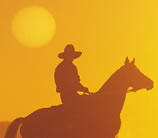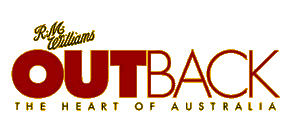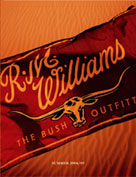OUTBACK STATIONS
Those wily Colonial boys
Story Sue Neales
Photos John Elliott
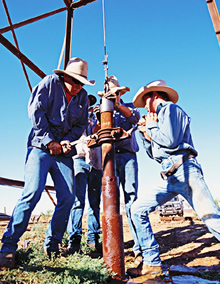 Peter
Edmonds finally has a grin on his sun-darkened face. After 18 months of
desperate drought, the channels and creeks of Keeroongooloo Station in far
western Queensland are full of water again. The Channel Country grass is
lush and green; Cooper Creek is brimming with water, fish and birds; and
the station's 15,000 Brahman-cross steers and bullocks are sleekly
white, fat and rounded.
Peter
Edmonds finally has a grin on his sun-darkened face. After 18 months of
desperate drought, the channels and creeks of Keeroongooloo Station in far
western Queensland are full of water again. The Channel Country grass is
lush and green; Cooper Creek is brimming with water, fish and birds; and
the station's 15,000 Brahman-cross steers and bullocks are sleekly
white, fat and rounded.
No more mustering stock in 57 degrees Celsius heat as Peter Edmonds, his partner Joanne Clanfield and their five young ringers endured in January when their most reliable bullock paddock fringing Cooper Creek ran out of water; no more longing for rain to water the parched red gibber ridges and fill dams and homestead tanks after receiving less than three inches of rain in 2002; and no more having to make phone calls to Colonial Agricultural Company's head office, trying to keep the quiet desperation and despair out of his voice.
"We were doing it pretty hard here for a while," says Peter, the 40-year-old manager of 1.4-million acre Keeroongooloo, near Windorah. "Then, just when it was getting really desperate, it rained. We had two inches in the second week of February, almost as much as in all of 2002. I just stood in it for what seemed like hours, and all my young fellows too. We knew then we'd come through our worst drought on record."
Listening intently to this tale of stoic survival is Fred Grimwade, managing director of Colonial Agricultural Company, now Australia's equal sixth largest cattle company (in cattle numbers), which owns nine prime rural properties across Queensland, the NT and northern NSW and a total herd of about 130,000 head. Sitting around the communal mess table, dressed in his polished boots, pressed trousers and neat blue shirt with a Colonial logo on the top pocket, Grimwade, 44, looks far removed from the daily grind of work on a station like Keeroongooloo. Not for him mustering in a heatwave, checking bores, carting water and enduring the sight of kangaroos dying of thirst and starvation in the homestead's red dust garden. Or the need to drench his workshirt in sweat and grease.
"My work is all up here," he says, tapping the side of his head. True enough, for this enthusiastic financier has virtually single-handedly reversed Colonial's long-term commitment to its string of cattle stations. Not that the former lawyer, merchant banker, venture capitalist and company secretary of Western Mining Corporation is a stranger to the cattle business. He grew up on his family's Glenaroua Angus stud that is still run by his younger brother and mother in central Victoria. This background, as well as his own recent experience with the group's cattle stations, has made him a firm believer in agricultural investment.
With a long agricultural pedigree and a financial background in New York, Sydney and Melbourne, Grimwade is exasperated that the rural sector doesn't receive serious investment attention. "One problem is that the public, including financial institutions, only hear how tough it is in the bush," he says. "They rarely hear how well farmers are doing. There are some very successful large private operators - as the Kahlbetzers have shown with their Twynam group - but they tend to just get on with what they're doing. So it's up to the rest of us, especially company groups, to be more open about the feasible and actual returns on our investment for the good of the whole agricultural sector long-term."
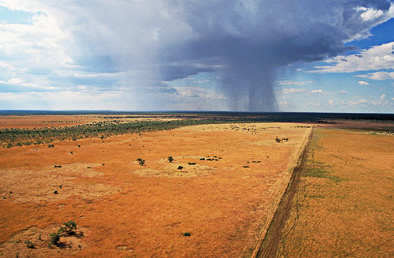
He is convinced that agriculture's reputation as a high-risk and volatile investment that lacks liquidity is unwarranted. His own experience managing Colonial's $170 million cattle business over the past five years has shown that a 10 percent return on capital on a sustained average basis is readily achievable across a well-run network of properties. "We've done better than that cyclically," he points out. "But consistent 10 percent-plus returns on assets are what we have to do to get people's attention and show the investment market that agriculture has a worthy place in any portfolio. That rate of return would keep any institution happy. The current depressed equity market has also reinforced the real benefits to a large investment portfolio of including an asset fund like ours, specialising in beef or agriculture, which is uncorrelated to other market movements."
Since taking over at Colonial Agricultural Group nearly five years ago,
Grimwade has been able to prove his point. After Colonial bought Prudential
Australia's life insurance business, Grimwade - as head of private
equity for Colonial First State Investments - saw an opportunity to combine
his financial and investment knowledge with his personal interest in beef
production.
Colonial's cattle portfolio is held as a dedicated managed fund, the
Colonial Agricultural Fund, with a total asset value of about $170 million,
which Grimwade manages for Colonial First State Investments. The Commonwealth
Bank and its shareholders don't own the stations, as has often mistakenly
been reported. They are owned mainly by former Prudential life insurance
policy holders and the Transport Workers Union Superannuation Fund as major
unitholders of the Colonial Agricultural Fund. (It was the Prudential Pastoral
Investment Fund before an earlier takeover.)
Back in 1999, Grimwade's first job was to convince the Colonial managed funds group to keep together the cattle property portfolio it had acquired. "The outlook for cattle was good back then, and Prudential's network of cattle stations was sound and well constructed," he explains. "I convinced the chairman that it was worth giving it a go and enhancing what we had, rather than selling the stations and fund immediately. At worst, I knew the group would be worth more in three years time after we had put in place a sound business plan, even if we still decided to sell. At best, I was hoping to show that the cattle group was an investment that gave solid returns; that we could keep, grow and enhance as a specialist investment vehicle in the future. It was like a three-year trial."
The sky is broodingly grey over the humid downs of the Barkly Tableland as a mob of well-fed white Brahman cows and calves quietly shift across the green expanse. In the distance, a shaft of heavy rain dumps its welcome load on the waiting earth below. In anywhere but northern Australia, the distant cloudburst would be falling on a neighbour's property, or even in the next town 10 kilometres away. But here at Walhallow, Colonial's prime 2.4 million-acre breeding station, everything is of such a big scale that the localised rain is pelting down in the next paddock.
Although the Barkly Tableland held its condition through 2001 and 2002 better than most other areas, Walhallow's manager, Cameron Fulcher, was still desperate for the northern wet season to kick in by February. Not only did Walhallow - one of Colonial's three main cattle breeding properties - receive 18 inches, or more than half its annual rainfall, in the two months to early April, its sister breeding station Armraynald near Burketown, received nearly 15 inches.
Walhallow's Cameron Fulcher and Paul Healy, manager of Armraynald, run the two northern breeding properties that are the veritable calf factories of the business - each running about 16,000 Brahman breeding cows and 800 Brahman and Charbray (Charolais-Brahman cross) bulls, and turning off 25,000 weaner calves a year. The weaners are sent south - usually by walking down the Georgina stock route - to Keeroongooloo for growing out and fattening, or to Yacamunda and Comely, the group's two central Queensland properties that are closer to the coastal abattoirs.
Now that Grimwade's trial period is over - and Colonial is saying loud and clear that its highly-profitable cattle business isn't for sale and instead is looking to grow - the success of the rigorous business plan and strategies imposed on the group is clear. All properties and livestock have been significantly improved; new bores and dams have been built, paddocks redesigned and new fences constructed; genetic improvement has been made to the herd, with new and younger bulls and a tougher regime of culling old cows and replacement heifers introduced. The changes have enabled carrying capacity to increase from 110,000 cattle to nearly 130,000, despite the drought and heavier selection strategies. Within two years - even without any property purchases - herd size should be above 140,000.
Most significant, says Grimwade, is the way the nine stations, their locations and sizes, give the entire group enormous flexibility, even though each property has its own production and turn-off targets. "The sum of the nine properties gives a much greater performance overall than each of them individually would indicate," he explains. "We don't run each separately and judge them on that basis. This is a portfolio and they each have a contribution to make to the bigger picture."
There are distinct production lines or units within Colonial's overall cattle group, which allow diversity and marketing flexibility. Santa Gertrudis, rather than Brahmans, are bred on Caldervale, a 380,000 acre central Queensland brigalow block near Tambo, and are grown out early on Colonial's two NSW properties near Tamworth and Moree. The meat from these Santa Gertrudis-British breed cross cattle is destined for premium local and Japanese beef markets, while Brahman beef product mainly goes to the US and lower grade Japanese exports.
At the same time, Grimwade is seeking chemical-free organic accreditation for parts of Caldervale. "It allows us to see if we can grow beef organically, in both a production and economic sense, before we expand any further," he explains. "We estimate we need a 20 percent premium for organic beef before it is worthwhile. But it also it shows us how the economics would work - or not - if markets such as Japan or the US ever demanded Australian beef producers stop using growth hormones. There's no sign of that yet - but this business is all about risk minimisation and you need to be prepared."
Kerry-Anne McGufficke of Armraynald station in the Queensland Gulf Country is rushing to farewell Fred Grimwade and livestock manager Mark Perkins before they fly to Walhallow.
But it's hard to rush when your feet are claggy with thick black
clay mud from trying to drag the mailman, on his weekly run from Cloncurry,
out of the sticky quagmire that the main road to Burketown turns into every
wet season.
"It's just another thing you get used to doing when you live
out here," says the wife of Armraynald manager, Paul Healy, and mother
of Karlea, 8, and Jake, 9, who are inside the main house doing School of
the Air from Mt Isa. "It's pretty hard to write a job description
when you live on a company station like Armraynald." Part of Kerry-Anne's
role is to run the office and paperwork side of the 508,000-acre prime breeding
property. It's a part-time job for which she gets paid, as do most
of the other partners who help run the group's other eight stations.
Then there's keeping track of 30,000 cattle, knowledge that is better stored in two heads than one. It also makes writing the weekly station progress report and stock audit much easier. There's also the Royal Flying Doctor medicine box to run, phones to answer, the guesthouse to maintain, provisions and stores to order, children to manage and young ringers to keep in order, plus secretaryship of the Burketown Rodeo and Campdraft committee. "Oh, I painted the station name on top of the machinery shed too," jokes Kerry-Anne, trying to wash the mud off her feet and encourage Paul to take the tractor down to help the stranded mailman.
The nine managers and their partners who run the group's stations are some of Colonial's most vital assets. Most are relatively young, between 30-40, and have worked on Queensland and NT stations for most of their lives. Most are married with young children. Several have been hand-picked by Colonial's pastoral manager John Hagan, a legendary fixture on outback stations as a former drover, station manager and company boss. He worked with many of the managers when they were young ringers fresh out of school, and has mentored their progress and development.
Most important, says Grimwade, is that the couples are enthusiastic, enjoy what they are doing and share the same mould and overall vision for what Colonial is trying to achieve.
Annual performance bonuses have give managers an incentive to share in financial success. Bonuses, accompanied by annual performance reviews and feedback, are paid according to how well targets (not always financial) and business aims for each station are met. Ongoing staff training is also being introduced, particularly for ringers, many of whom fled school at 15 or 16. A special skills development short-course in chemicals, small motors, horsemanship, welding and first aid is being organised at Dalby Agricultural College this year for the ringers.
Armraynald manager Paul Healy says, "I really enjoy that we aren't on our own, that we are doing a joint operation with other managers and staff. We talk on the phone a fair bit, and it's a good feeling when you see our cattle killed at the Biloela abattoir, for example, and know that they were born at Armraynald, grown and fattened at Keeroongooloo and Comely. It's good to be part of a bigger picture."
Keeroongooloo manager Peter Edmonds and his partner, sparky Jo Clanfield, are also ardent Colonial fans. Having worked for private station owners, Peter says, "Smaller owners tend to be a lot tighter with their pennies, especially on things like food, horses and everything around the homestead for the staff, whereas companies like Colonial look after their people better. During the drought it was really hard on morale, but the company couldn't have done more for us."
But both Jo and Peter agree that station managers require a strong sense of responsibility. When managing for a private owner, much of the burden of economic outcomes is worn by the owner. But Peter says he in no doubt that the responsibility for the station, its cattle, budgets and contribution to the group effort and success rests squarely with him.
A highlight for all of Colonial's station managers and their partners is the annual conference get-together in Rockhampton or Cairns. Lasting a week, it is both a serious meeting between Grimwade, Perkins, Hagan and their managers to discuss the next year's business plan and budgets, and a forum to canvass new ideas and directions. "There's one session which partners attend which is for airing all those whinges and gripes you have been saving up all year," says Felicity Fulcher of Walhallow Station, with some relish. "But it's a great time too, and it's always good to get away, because we are pretty isolated here."
But station life isn't as tough as it once was. The days of power
generators, dirt roads and no communications are almost gone. Walhallow
has a bitumen highway to its front gate, Armraynald has mobile phone coverage,
and even Keeroongooloo has town power. Even droughts and hardship don't
faze experienced managers like Peter Edmonds. It comes with something Grimwade
says is essential in his managers - a positive outlook. "In
fact, I'm glad we came in November 2001 to Keeroongooloo, to what
was the beginning of the worst time here ever," says Peter, as the
red desert around his home is tinged with green. "Because now I've
seen what the worst is, I know how to cope with it. Now I just want to have
the pleasure of seeing the best of it too!" ![]()
Full story: OUTBACK, June/July 2003
